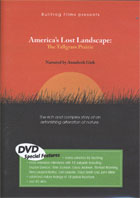
America’s Lost Landscape: The Tallgrass Prairie 2005
Distributed by Bullfrog Films, PO Box 149, Oley, PA 19547; 800-543-FROG (3764)
Produced by David O’Shields & Daryl Smith
Director David O’Shields
DVD, color, 55 min.
Jr. High - Adult
Midwest settlement, Ecology, Environmental Studies, History, Conservation, Land Restoration
Date Entered: 04/24/2007
Reviewed by Elise Torre, MLS, Reed Library, State University of New York College at FredoniaBetween 1830 and 1900 the most astounding environmental transformation engineered by man took place. 240 million acres of prairie between southern Canada and the mouth of the Mississippi became extinct. In 70 years corn, soybeans, hogs, and cattle replaced a one million year old ecosystem.
The focus of this film is the destruction of the prairie and efforts to restore it. Man has always worked to control the landscape of the Midwest. Native Americans set controlled fires and 19th century settlers intended to “turn the wilderness into something productive.” However, the purpose of this film is not to assign blame but to examine the forces that converged to change the land on a massive scale. The anthropology, ecology, history, philosophy, and the politics that surrounded the prairie are discussed clearly and factually using high production values.
Numerous experts on the subject were interviewed and their responses were skillfully edited to support each chapter. Fortunately many of the outtakes were collected and made available through the “Special Features” link in the DVD menu. These segments almost stand on their own as jumping off points for open discussion. Stunning photography, an evocative musical score, and engaging narration support the film’s well-researched concepts.
Teachers and groups who do not have time to view the entire disc, will be happy to know that the film is divided into thirteen teaching segments including: The Lost Landscape; Exploration and Expansion, Prairie Ecosystem, and the Prairie and Agriculture.
This film is highly recommended for junior high school through college and adults It should appeal to groups interested in ecology, agriculture, U.S. western migration, horticulture, and gardening. It is an excellent tool for teachers who are interested in thought-provoking classroom discussions.
Awards
- Pare Lorentz Award, International Documentary Association Awards
- Hazel Wolf Environmental Film Festival, Best of Festival List
- Wild Rose International Film Festival, Best of Festival
- CINE Golden Eagle